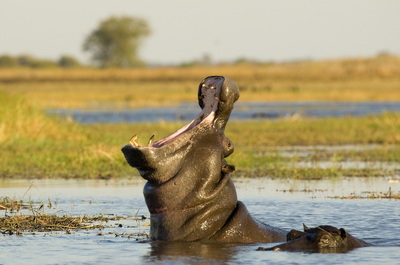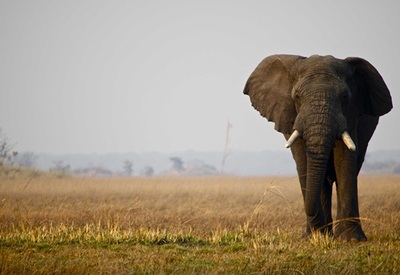Kafue National Park
Kafue is Zambia’s biggest National Park, and is some two and
a half times the size of South Luangwa. Established in 1924, Kafue National Park covers 22,400km2 (corresponding the
size of Wales, or the US State of Massachusetts). Terrain is varied, and not
surprisingly, the geography varies considerably. The permanent Kafue River
follows a well-defined course through the Park.
Bordering the eastern side of southern Kafue is Lake Itezhi-Tezhi – a large man-made lake, created in 1977, which is designed to regulate the water levels for the Kafue Gorge Hydroelectric Dam.
Kafue is bisected by a tarred road, and is also surrounded by a number of Game Management Areas (quite a common arrangements with many National Parks), which allows for more land under Conservation.Most of Kafue is made up of Miombo (broadleaf) woodlands and dambos, within which there are smaller patches of munga woodland. In addition there are bands of riparian forest and thickets along the larger rivers.
The well-know Busanga Swamps are in the northwest, and are surrounded adjacent floodplains. These are dotted with raised 'tree islands', which include some large specimens of sycamore figs. Surrounding the floodplains are open grasslands.
As the north of Kafue receives slightly more rain than the south, there tends to be more varied and bigger trees. In contrast, the southern Kafue is dominated by areas of Kalahari sand (which extends all the way from northern South Africa), due to the lower rainfall. At the very southern area of the Park, there are the Nanzhila Plains, which are home to expanses of grassland, dotted with islands of vegetation and large termite mounds. Here you will also find baobabs, or jackalberry trees.
As Kafue is so vast, and houses a good variety of habitats, it is not surprising that there is an equal diversity of wildlife. Antelope, in particular, are well represented, and in the Busanga swamps you will find the shy sitatunga (more commonly associated with Botswana’s Okavango Delta). The neighbouring Busanga Plains is a large area, which are seasonally affected by rainfall, making them impassable until June of each year. Here you will find herds of red lechwe, and puku, along with plains zebra and blue wildebeest. There is also the chance of see both roan and sable antelope
Further south, you will find kudu, bushbuck, eland reed buck and the Defassa waterbuck (which is more associated with East Africa.
Perhaps not surprisingly, the southern section of the park game viewing is somewhat different, with the Lodges in Game Management Areas acting as buffers to protect wildlife. Here you will find impala and bushbuck. The section from Itezhi-Tezhi south to Ngoma has the Park’s densest elephant population, with some groups also found in the Chunga area. Lion are well represented in the park and found in most areas. Leopard are quite common in the main forested areas of park, which is to be expected.
In terms of other predators, spotted hyena are seen regularly, throughout the park. They appear to occur in smaller numbers than either lions or leopards. Cheetah, while not common, are seen in the Busanga Plains area. The endangered wild dog are found in Kafue, particularly in the northern sections.Buffalo are widely distributed throughout the park, but seem not to be common, though herds do frequent the Busanga Plains.
The Kafue River, with its larger tributaries such as the Lunga, known for hippo and crocodile. Vervet monkeys and yellow baboons are also well represented in the Park.
Bird lovers will enjoy Kafue, as there are some 495 recorded species. This is a reflection on Kafue's wide range of habitats. Wetlands and floodplains have the full range of herons, storks and ibises, along with crowned and wattled cranes, Denham's (or Stanley's) and kori bustards, secretary birds, and a multitude of geese (both spur-winged and Egyptian).
Kafue's extensive miombo woodlands are home to endemics such as pale-billed hornbill, miombo pied barbet, grey tit, miombo rock thrush, Sousa's shrike, chestnut-mantled sparrow-weaver, spotted creeper, and three species of eremomela, for example.
The best time for wildlife sightings is generally in the dry season from May to October, but the Kafue is at its most beautiful after the rains, in the first part of the year - however many roads are impassable from November to April.
Bordering the eastern side of southern Kafue is Lake Itezhi-Tezhi – a large man-made lake, created in 1977, which is designed to regulate the water levels for the Kafue Gorge Hydroelectric Dam.
Kafue is bisected by a tarred road, and is also surrounded by a number of Game Management Areas (quite a common arrangements with many National Parks), which allows for more land under Conservation.Most of Kafue is made up of Miombo (broadleaf) woodlands and dambos, within which there are smaller patches of munga woodland. In addition there are bands of riparian forest and thickets along the larger rivers.
The well-know Busanga Swamps are in the northwest, and are surrounded adjacent floodplains. These are dotted with raised 'tree islands', which include some large specimens of sycamore figs. Surrounding the floodplains are open grasslands.
As the north of Kafue receives slightly more rain than the south, there tends to be more varied and bigger trees. In contrast, the southern Kafue is dominated by areas of Kalahari sand (which extends all the way from northern South Africa), due to the lower rainfall. At the very southern area of the Park, there are the Nanzhila Plains, which are home to expanses of grassland, dotted with islands of vegetation and large termite mounds. Here you will also find baobabs, or jackalberry trees.
As Kafue is so vast, and houses a good variety of habitats, it is not surprising that there is an equal diversity of wildlife. Antelope, in particular, are well represented, and in the Busanga swamps you will find the shy sitatunga (more commonly associated with Botswana’s Okavango Delta). The neighbouring Busanga Plains is a large area, which are seasonally affected by rainfall, making them impassable until June of each year. Here you will find herds of red lechwe, and puku, along with plains zebra and blue wildebeest. There is also the chance of see both roan and sable antelope
Further south, you will find kudu, bushbuck, eland reed buck and the Defassa waterbuck (which is more associated with East Africa.
Perhaps not surprisingly, the southern section of the park game viewing is somewhat different, with the Lodges in Game Management Areas acting as buffers to protect wildlife. Here you will find impala and bushbuck. The section from Itezhi-Tezhi south to Ngoma has the Park’s densest elephant population, with some groups also found in the Chunga area. Lion are well represented in the park and found in most areas. Leopard are quite common in the main forested areas of park, which is to be expected.
In terms of other predators, spotted hyena are seen regularly, throughout the park. They appear to occur in smaller numbers than either lions or leopards. Cheetah, while not common, are seen in the Busanga Plains area. The endangered wild dog are found in Kafue, particularly in the northern sections.Buffalo are widely distributed throughout the park, but seem not to be common, though herds do frequent the Busanga Plains.
The Kafue River, with its larger tributaries such as the Lunga, known for hippo and crocodile. Vervet monkeys and yellow baboons are also well represented in the Park.
Bird lovers will enjoy Kafue, as there are some 495 recorded species. This is a reflection on Kafue's wide range of habitats. Wetlands and floodplains have the full range of herons, storks and ibises, along with crowned and wattled cranes, Denham's (or Stanley's) and kori bustards, secretary birds, and a multitude of geese (both spur-winged and Egyptian).
Kafue's extensive miombo woodlands are home to endemics such as pale-billed hornbill, miombo pied barbet, grey tit, miombo rock thrush, Sousa's shrike, chestnut-mantled sparrow-weaver, spotted creeper, and three species of eremomela, for example.
The best time for wildlife sightings is generally in the dry season from May to October, but the Kafue is at its most beautiful after the rains, in the first part of the year - however many roads are impassable from November to April.




